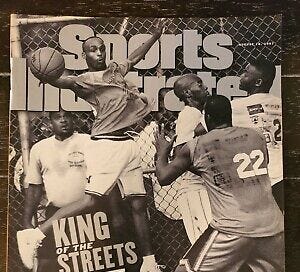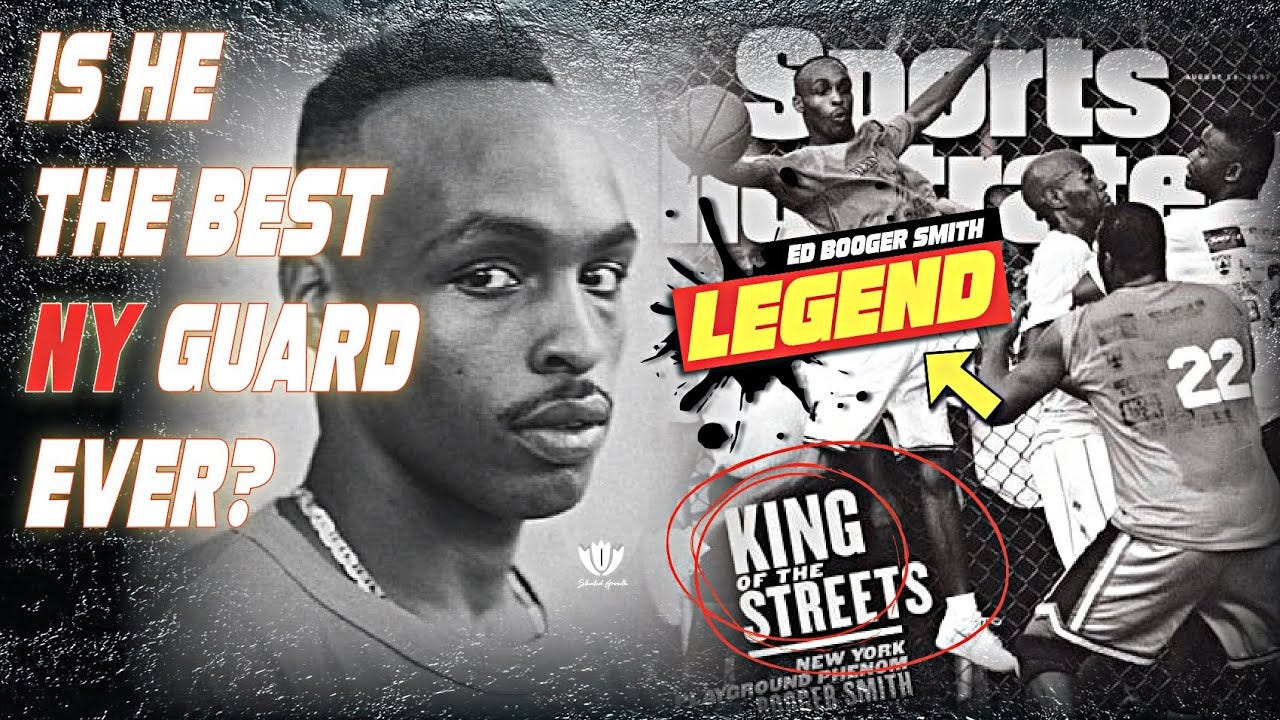Brooklyn Boogs
Shoutouts to Die Hard Knicks Podcast Host Eru he asked me to write an article about a Street Ball NYC Brooklyn Legend Ed “Booger” Smith. Shoutouts to Tompkins Projects in Brooklyn.
Ed “Booger” Smith was born on November 27, 1973, in the Tompkins Projects of Brooklyn, New York. Growing up in one of the city’s toughest neighborhoods, Booger would become one of the most electrifying streetball legends to ever grace New York’s playgrounds. A gifted point guard with unparalleled court vision and a flashy ball-handling style, Smith was poised to make a mark far beyond the chain-link fences of the city’s basketball courts. Yet, despite his immense talent and moments of fame, his life became a tale of unfulfilled potential, shaped by poverty, poor decisions, and the streets he could never leave behind.
A Playground Prodigy
From an early age, basketball became both a refuge and an arena for Booger. By the time he was 13 years old, he was competing against and outplaying older, more experienced players on the courts of Brooklyn. His flashy passes, dizzying crossovers, and effortless ability to control a game made him a standout. His nickname, “Booger,” stuck as a term of endearment, but his game was anything but soft.
Despite his natural talent, Booger’s upbringing was far from stable. He grew up in a single-parent home and never met his father. His relationship with his mother, Brenda Smith, was turbulent, leading to periods of homelessness and a life on the streets. By the time he was 12, Booger was selling drugs to survive, stuffing his “work” into his socks during games. He spent nights sleeping on park benches or in hallways, navigating a world of violence and desperation.
High School Years: A Rollercoaster
Booger briefly attended Westinghouse High School, where his talent shone on the basketball court. Named All-City as a junior, he was already considered one of the best players in New York. Yet his academic struggles and street activities overshadowed his achievements. Teachers and school officials, eager to see him succeed, manipulated his grades to keep him eligible for basketball, but Booger eventually dropped out after three years.
His dreams of basketball glory were always in conflict with his reality. “I wasn’t a bad person,” Booger once said, “but I did what I had to do to survive.”
The Rise of Kenny’s Kings
In the early 1990s, Booger became the star player for Kenny’s Kings, a Brooklyn-based streetball team coached by Kenny Jones. Jones acted as a mentor and father figure to Booger, providing him with a semblance of stability during a chaotic time. The Kings were a powerhouse on the New York summer basketball circuit, with Booger leading the charge as the team’s creative engine.
Their story was captured in the 1997 documentary Soul in the Hole.
Directed by Danielle Gardner, the film showcased Booger’s dazzling basketball skills while offering an unfiltered look at his turbulent life. “I think people got scared when I said if I didn’t make the NBA, I’d sell drugs,” Booger later reflected. “But that was my reality. I wasn’t going to lie and say I’d become an architect.”
The documentary and a cover story in Sports Illustrated that same year catapulted Booger to national fame. The August 18, 1997, issue of SI featured a photo of him mid-air, completing one of his signature no-look passes. Yet fame didn’t bring him closer to his NBA dreams—it only magnified the struggles he faced.
A Shot at College
Encouraged by Kenny Jones and basketball scout Tom Konchalski, Booger enrolled at Arizona Western College in Yuma for the 1993–94 season. It was his first real opportunity to leave the streets behind and focus on his game. In his lone season, he averaged 23.1 points per game, showing flashes of brilliance.
However, the transition to structured basketball and college life proved challenging. Booger struggled to adapt, both on and off the court. “When I was heading out there, I thought I’d change my life,” he admitted. “But as soon as I got there, one of my teammates had a pound of weed under his bed. Everybody on our team was from the streets.”
By 1994, Booger had returned to Brooklyn. Attempts to re-enroll at Arizona Western failed, and his once-promising college career ended as quickly as it began.
Streetball Stardom and Missed Opportunities
Back in New York, Booger remained a playground legend but never achieved the stability needed to turn his talent into a professional career. He had brief stints with minor league teams, including the La Crosse Bobcats (CBA), the Brooklyn Kings (USBL), and the Rochester Skeeters (IBA). Despite his undeniable skill, he never completed a full season with any team.
Booger’s brushes with the professional basketball world were fleeting. He even played in a pickup game with Michael Jordan in 2001 at Tim Grover’s gym in Chicago. Grover invited him to a pro tryout camp, but administrative issues prevented Booger from participating. It was a missed opportunity that could have been a turning point in his life.
Life Behind Bars and Beyond
In 2004, Booger’s life hit rock bottom. Arrested on charges of weapon possession and conspiracy, he was sentenced to prison, where he spent four years. Behind bars, basketball remained a part of his life. Fellow inmates recognized him from Sports Illustrated and Soul in the Hole, and he often played in prison leagues.
Released in 2008, Booger struggled to find direction. He coached youth basketball and maintained a good relationship with his daughter, Tanesia, but the challenges of rebuilding his life were immense. Without job prospects or the resources to leave Brooklyn, he remained tied to the streets that had shaped him.
Why Booger Never Made the NBA
For all his talent, Booger Smith never made it to the NBA because of a combination of factors:
1. Lack of Structure: Growing up without stable guidance or resources, Booger struggled to navigate the structured environments of high school and college basketball.
2. Off-Court Challenges: His involvement in street life, including drug dealing and criminal activity, consistently derailed his basketball aspirations.
3. Missed Opportunities: From leaving Arizona Western to skipping pro tryouts, Booger’s inability—or unwillingness—to capitalize on opportunities kept him from progressing.
4. Fear of Success: Those close to him, including Kenny Jones, believed Booger was afraid of leaving the world he knew behind. “Other people wanted more for him than he wanted for himself,” Jones once said.
The Legacy of a Legend
Today, Ed “Booger” Smith remains a symbol of raw talent and unfulfilled promise. His story is both a cautionary tale and a celebration of New York’s rich basketball culture. “Booger was about the last guy who came up in the streets through word of mouth alone,” journalist Rick Telander said. “He didn’t need to be in front of 20,000 fans all he needed was a few hundred people leaning up against a fence
Though he never reached the NBA, Booger’s impact on streetball is undeniable. His name still resonates on the playgrounds where legends are born, a reminder of both the heights and depths of the game.
Thankyou reader for enjoying another State Substack Peace and Blessings
Shoutouts to my favorite basketball documentary ever Hoop Dreams:






